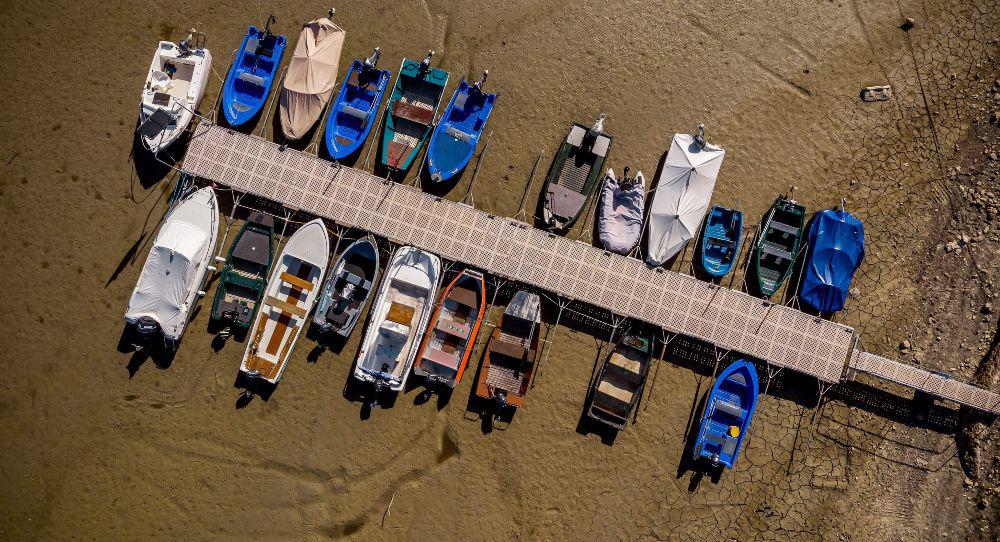In March 2023, the UN held a conference on the future of water in a world increasingly affected by climate breakdown.
Water is both a direct victim of global warming as well as a major factor in its effects. A warming world naturally leads to more water evaporating in the atmosphere, causing droughts, shrinking water resources, and the salinization of soils. These risks quickly translate into social and political instability.
Europe is already experiencing the results of growing water scarcity. Droughts are becoming geological. In a country like France, this is no longer just limited to trade passages as a result of rivers drying up or shrinking agricultural outputs. It is also causing increased political polarization and civic violence.
In response to the droughts, the French government has decided to build water catchment infrastructure specifically designed to bring additional support to agricultural producers. But the water catchment structures, called “bassines,” have become the physical embodiments of divisions between those who favor risk mitigation strategies in the face of climate change, aiming to continue agricultural business as usual; and those who favor systems change, supporting more environmentally friendly and localized agriculture.
The first group fears the short-term effects of drought and economic shocks. The second fears long-term effects of water rationing and forms of agriculture that accelerate climate and biodiversity breakdown.
The gravity of the situation in France is only a teaser for what is to come in future years. Quite frankly, it is also a mild reality compared to countries in the Middle East and North Africa.
During the UN water conference, UN Secretary General António Guterres called for game-changing approaches in the fields of agriculture, infrastructure, sanitation, and information systems to monitor water resources and their allocations.
But the World Resource Institute found that of all the 719 water commitments that public and private sector actors made at the conference, barely a quarter are likely to have an actual game-changing impact.
The EU came to the 2023 water conference with about 30 commitments, ranging from combating pollution and bolstering climate adaptation and disaster risk reduction, to restoring biodiversity and investing in the circular economy.
These are all mutually reinforcing and necessary steps. But there is an additional one that the EU should take, for its own sake and for the collective good: bolstering research on the hydrological cycle and on atmospheric river mapping, and supporting complex regeneration at ecosystems and regional scales.
More water entering the atmosphere supercharges the effects of carbon dioxide and climate disruptions, such as droughts, floods, fires as well as cyclones.
One of humanity’s most urgent tasks is to plant water back into landscapes so as to stall, if not reverse, the scarcification of liquid and accessible water sources. The latter are also called “blue water,” often materializing in lakes and rivers for example.
Blue waters are supported by “green water,” contained in soils and vegetation, which helps to regulate the movement of water from liquid to gas, as moisture moves through the atmosphere and keeps ecosystems in a state of equilibrium and sustenance. Bolstering the replenishment of blue waters requires rebuilding green waters. In other words, the world needs to regenerate in ways that are infinitely more complex than simply planting monocultures of trees. Entire ecosystems need to be brought back to life, including in the most arid areas, starting yesterday.
So, what can Europe do?
On the first day of COP27, Egypt signed into implementation the first steps of the complex Sinai regeneration project. The engineering behind it is elaborate and ambitious. But the logic is simple: regenerate the Sinai, stabilize the regional hydrological cycle, and increase the chances of rebuilding rainfall patterns that will buffer against climate breakdown and be adaptation-innovative.
The hidden logic behind the project is that complex regeneration can happen sequentially between various ecosystems around the world. If done right, there may be a chance to rebuild the ecological interdependencies between ecosystems that strengthen the transport of moisture into the atmosphere with the type of stability that existed before anthropogenic disturbances reached a tipping point.
If this sounds wild, expensive, or untested, try imagining a world where millions of people have no access to water. Picture the consequences. The world has entered uncharted territory—ensuring safety will require testing approaches that fall outside the remit of boundaries.
At the water conference, the German government came with a pledge to support the restoration of the Niger River. This is another step in the right direction. But the EU can help to take this forward in a more ambitious manner. For more than a decade, the union has been developing a strong narrative around water diplomacy. In practice, though, this has amounted to very little because the EU narrowly sees water diplomacy as a tool to manage the effects of scarcity rather than combat and reverse it. The bloc has at its disposal elaborate scientific imagery and data processing capacity, innovative experts and state-of-the-art satellite technology.
Now is the time for Europe to take initiative and innovate on the basis of real climate leadership. Practical steps Brussels could consider include: investing in dynamic mapping of atmospheric rivers and hydrological cycling; modeling inter-ecosystems teleconnections and regeneration sequencing; directing climate finance into scaling-up regeneration efforts; and strengthening diplomatic outreach and technical support for transboundary water governance.
The EU’s water governance strategy must be expanded beyond visible and scarce water resources. It should support the development of new governance paradigms that take a holistic view of water, and should seek to coordinate state and civic actors in an effort to rehydrate the Earth.
The future of European and global security depends on it.


.jpg)
.jpg)


